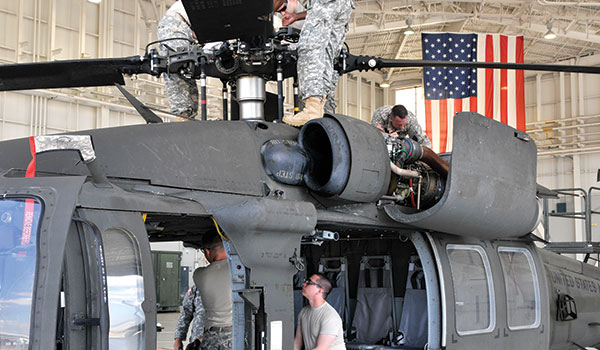
Reserve Component Aviation Update / By COL J. Ray Davis: Greetings again from your Army National Guard (ARNG). I just took over the reins of the ARNG Aviation and Safety Division from Mark Weiss. Mark left behind some incredibly big shoes to fill, but I’m fortunate to have a great team that will help me do so.
I’d like to publicly thank Mark for his 28-plus years of service, as he heads off to retirement and another chapter in what’s been an amazing life thus far.

Aircraft mechanics with 1st Bn., 185th Avn. Regt., Mississippi Army National Guard perform scheduled maintenance on a UH-60 Black Hawk helicopter May 6, 2014 at the Combat Readiness Training Center in Gulfport.
For my first crack at this, I’d like to talk about ARNG Aviation Maintenance – specifically a recent initiative that we hope will bear (large) fruit, and one that I’d like your help refining.
For the past 2-plus years, we at the Guard have employed a quarterly Aviation Scorecard. This readiness assessment tool was designed as a supplement to the Commander’s Unit Status Report (CUSR), to help state army aviation officers (SAAOs) “see themselves” (i.e., their units); to help the Director, ARNG ensure that his resources are optimally applied; and to help our Aviation & Safety Division identify force-wide trends. Ultimately it aims to improve our readiness nationally, through the timely application of resources and sharing of best business practices.
Recently, we added a Logistics Module to the Scorecard, to help our Army Aviation Support Facility (AASF) commanders “see themselves.” We’ve long believed that a Fully-Mission Capable (FMC) rate, by itself, is an insufficient performance metric, and that other attribute measurements are needed to provide a complete picture of a facility’s maintenance practices and outcomes. So, currently, we are measuring 7 attributes that describe the performance and character of an AASF (since the ARNG primarily does facility-based maintenance, rather than unit-based maintenance, in peacetime):
- Fully-Mission Capable (FMC) Rate – This is the standard DA 1352 statistic, measured over the reporting quarter. As with all our metrics, we mathematically compare performance (in this case the FMC percentage) to a standard (in this case, 75%). So an FMC score of 1.0 means “we’re meeting the standard.”
- Mission-Capable (MC) Rate – For peacetime Guard operations, MC is often more important than FMC…has the facility put up enough aircraft to meet the next day’s training missions?
- Bank – This is the classic “surge capacity” metric that helps ensure a reasonable phase flow, and also provides a “new-to-theater”, learning-curve buffer.
- Production – This metric reflects how many phases have been accomplished in the past reporting period – how many flight hours has the maintenance program “produced.”
- Service Velocity – How long does it take (in Non-Mission Capable hours) to complete an intermediate service? This helps assess scheduled maintenance practices and the level of training within the facility’s maintenance teams. Ideally, we’d look at all scheduled services, especially phases, but we chose the intermediate service initially, since it occurs frequently enough to gather sufficient trend data.
- Critical Skills – How well-stocked is the facility with maintenance test pilots, non-destructive inspection (NDI) inspectors, and confined space maintainers – those folks who are indispensable to rapid repair and testing?
- Personnel – How well-manned is the facility with full-time maintainers? Have wrench-turners been diverted to other, non-maintenance duties? Is recruiting up to snuff?
We’re refining two other logistics metrics, and hope to have them in place at the beginning of 2016: - Cost-Efficiency – How much is the facility spending on repair parts (by Mission-Design-Series)? Is the facility’s troubleshooting effective and sufficient? Ideally we’d like to identify how much is being spent on each tail number, but so far we haven’t figured out how to pull that data from our automated systems (AMCOM: we could use some help here – wouldn’t it be nice to really know which aircraft are the parts-dogs?).
- Maintenance Quality – How good is the maintenance the facility is doing? How many precautionary landings, mission-failures, and delayed take-offs are due to maintenance? Turning a phase overnight is of marginal benefit if those aircraft have poor reliability.
As with our unit-based Readiness Module (which employs aviation-based manning and training metrics), our Logistics Module promises to be a useful tool. We strive not to make decisions based on just one report, but rather to identify fleet-wide trends and star-performers who can “pull us” to higher readiness.
We’d like to hear from you. Send me your ideas and thoughts, and if found beneficial, we’ll incorporate them into our Scorecard Block III, which will debut in early 2016.
Fix Well, Fly Often, Stay Guard.
COL J. Ray Davis is the chief of the Army National Guard Aviation and Safety Division located in Arlington, VA.







